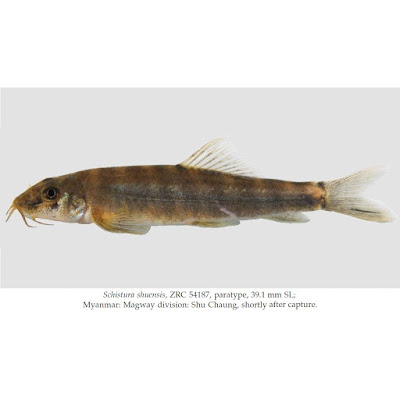[Most Recent Entries] [Calendar View]
Friday, September 30th, 2016
| Time | Event | ||
| 2:47p | [Ichthyology • 2014] Schistura shuensis • A New Species of Loach (Teleostei: Nemacheilidae) from Myanmar
Abstract Schistura shuensis, new species, is described from Shu stream on the eastern slope of the Rakhine range in Myanmar. It reaches up to 39.1 mm SL and is diagnosed by a combination of the following characters: males with suborbital flap, bearing tubercles on its posterior part, females with suborbital groove; caudal fin deeply forked (mean length of median caudal-fin rays 57 % of length of upper caudal lobe); caudal peduncle shallow (depth 11-12 % SL and 49-63 % of body depth); and presence of 6-9 indistinct dark brown bars on body. Joerg Bohlen and Vendula Šlechtová. 2014. Schistura shuensis, A New Species of Loach from Myanmar (Teleostei: Nemacheilidae). Ichthyological Exploration of Freshwaters. 24(3): 217-223. | ||
| 3:30p | [Ichthyology • 2016] Etmopterus alphus • A New Lanternshark (Squaliformes: Etmopteridae) from the south-western Indian Ocean
Abstract A new species of lanternshark, Etmopterus alphus (Squaliformes: Etmopteridae), is described from the south-western Indian Ocean. The new species resembles other members of the ‘Etmopterus lucifer’ clade in having linear rows of dermal denticles and most closely resembles E. molleri from the south-western Pacific. The new species is fairly common along the upper continental slopes off central Mozambique, at depths between 472 and 558 m, and is also found on the southern Madagascar Ridge in 650–792 m depth. It can be distinguished from other members of the E. lucifer clade by a combination of characteristics, including arrangement of flank and caudal markings, dimension of flank markings and shape, size and arrangement of dermal denticles along the body. Molecular analysis further supports the distinction of E. alphus from other members of the E. lucifer clade. Keywords: Chondrichthyes, elasmobranch, Etmopterus lucifer clade, Madagascar Ridge, molecular analysis, Mozambique, new species, Ebert, D.A., Straube, N., Leslie, R.W. and Weigmann, S. 2016. Etmopterus alphus n. sp.: A New Lanternshark (Squaliformes: Etmopteridae) from the south-western Indian Ocean. African Journal of Marine Science. DOI: 10.2989/1814232X.2016.1198275 | ||
| 3:38p | [Paleontology • 2016] Extreme Modification of the Tetrapod Forelimb in a Triassic Diapsid Reptile, Drepanosaurus unguicaudatus
Highlights - Three-dimensional fossils of the Triassic diapsid Drepanosaurus are described - Fossils support hypothesis that the forelimb is unique among tetrapods - The radius and ulna are unequal in length, and two carpals are longer than the radius - Forelimb range of motion and large claws suggest specialized hook-and-pull digging In Brief Pritchard et al. describe new fossils of the Triassic diapsid Drepanosaurus. Previously known from a single crushed skeleton, the new three-dimensional fossils show a unique forelimb with asymmetric radii and ulnae and elongate carpals. The forelimb and enlarged second manual ungual suggest a digging similar to modern anteaters. SUMMARY The tetrapod forelimb is one of the most versatile structures in vertebrate evolution, having been coopted for an enormous array of functions. However, the structural relationships between the bones of the forelimb have remained largely unchanged throughout the 375 million year history of Tetrapoda, with a radius and ulna made up of elongate, paralleling shafts contacting a series of shorter carpal bones. These features are consistent across nearly all known tetrapods, suggesting that the morphospace encompassed by these taxa is limited by some sort of constraint(s). Here, we report on a series of three-dimensionally preserved fossils of the small-bodied (<1 m) Late Triassic diapsid reptile Drepanosaurus, from the Chinle Formation of New Mexico, USA, which dramatically diverge from this pattern. Along with the crushed type specimen from Italy, these specimens have a flattened, crescent-shaped ulna with a long axis perpendicular to that of the radius and hyperelongate, shaft-like carpal bones contacting the ulna that are proximodistally longer than the radius. The second digit supports a massive, hooked claw. This condition has similarities to living ‘‘hook-and-pull’’ digging mammals and demonstrates that specialized, modern ecological roles had developed during the Triassic Period, over 200 million years ago. The forelimb bones in Drepanosaurus represent previously unknown morphologies for a tetrapod and, thus, a dramatic expansion of known tetrapod forelimb morphospace. Adam C. Pritchard, Alan H. Turner, Randall B. Irmis, Sterling J. Nesbitt and Nathan D. Smith. 2016. Extreme Modification of the Tetrapod Forelimb in a Triassic Diapsid Reptile. Current Biology. 212-Million-Year-Old Reptile Had Anteater-Like Arms | Popular Science http://po.st/G4rKRT via @PopSci |
| << Previous Day |
2016/09/30 [Calendar] |
Next Day >> |






